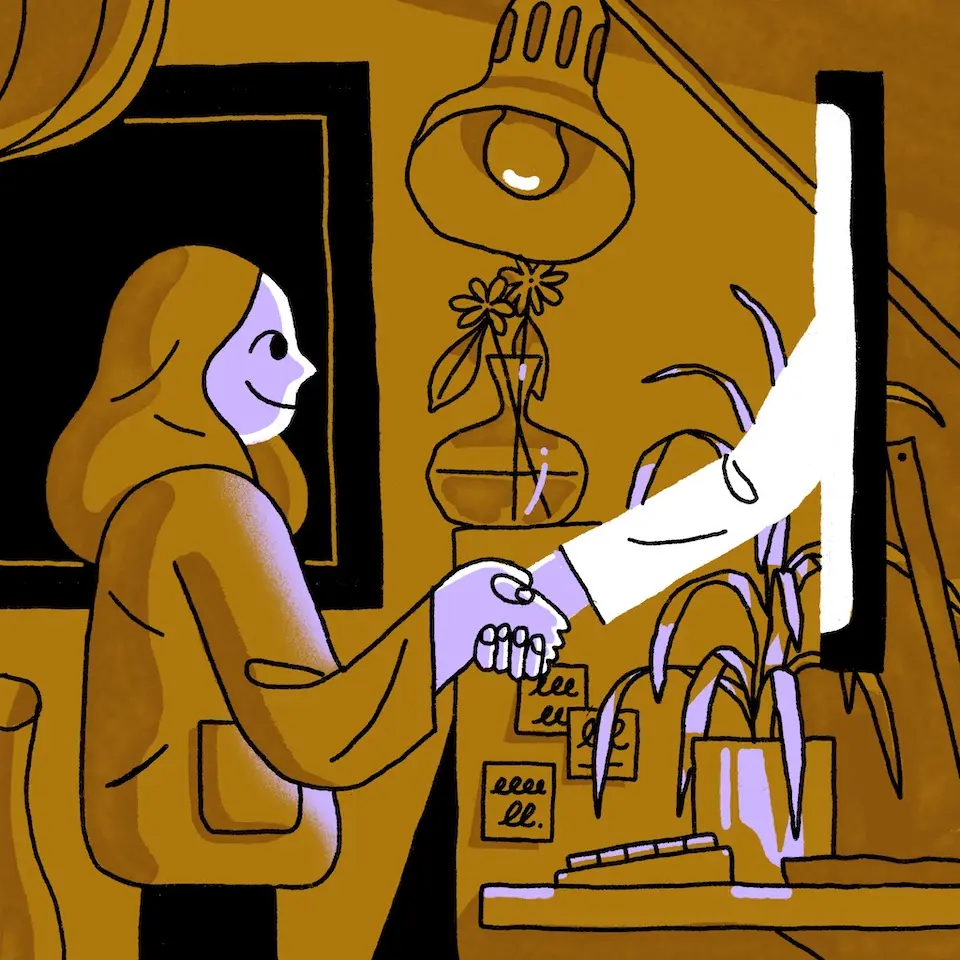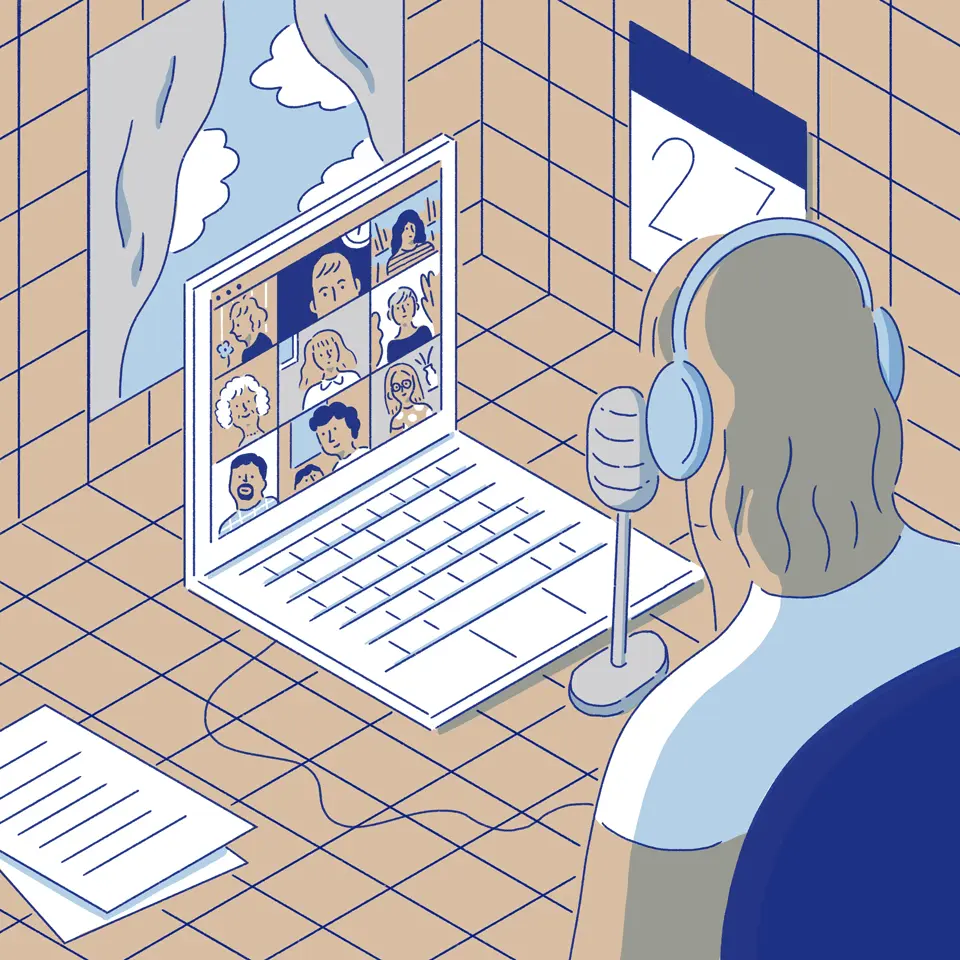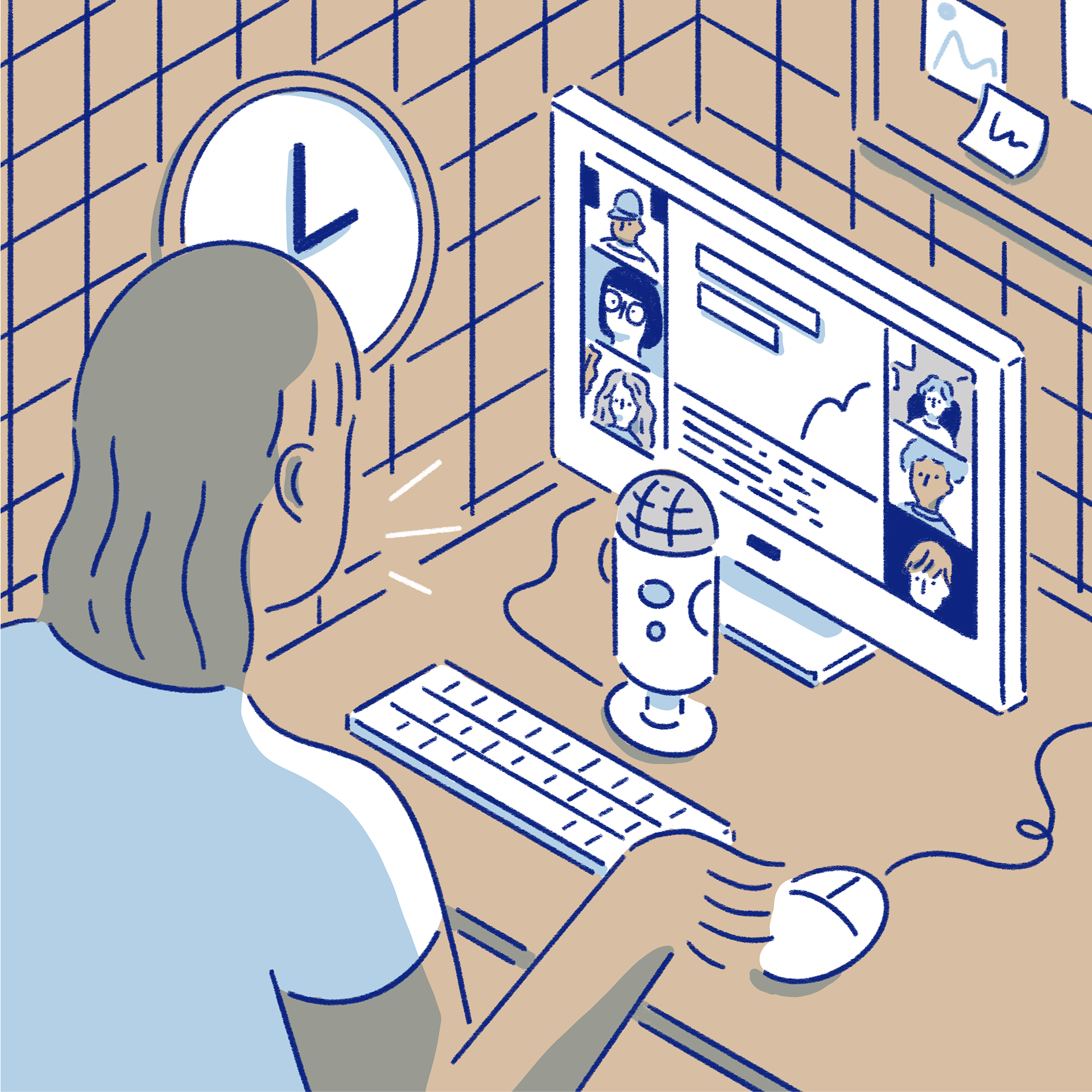
Making a real connection isn’t always automatic. Sometimes you see the person. Sometimes you just see the screen.
The other day, a colleague and I were talking about the pros and cons of looking at the green dot on the web cam when you’re on a video call. On one hand, it creates the illusion of direct eye contact for the person on the other end. On the other, everyone knows it’s a performance—and looking at that green dot actually prevents you from seeing their eyes on the screen.
So what’s better—performing eye contact or paying attention to facial expressions? Sometimes, direct eye contact feels more intimidating than intimate, depending on who’s doing the staring (and how often they blink). But no matter your seniority or level of extroversion, we’ve all wrestled with how to adapt our eye contact, body language, and voice, knowing they translate differently through a small electronic portal.
And after a year of looking at each other looking at our computers, the rules of real-life rapport can feel like a fading memory. Here, we offer advice for three-dimensional humans connecting on two-dimensional screens.
Zoom out for the bigger picture
Though we tend to focus on the eyes and facial expressions, you can still tell a lot about someone’s mood by the small amount of body language and gestures visible on a video conference. These are cues to ask how they’re doing if they seem especially stressed or tense. Plus, once you’ve learned their mannerisms, researchers say mirroring them can help create rapport.
But in addition to staying tuned into the body language of others, keep in mind that others can see your body language as well. And there are three specific things one BBC reporter suggests that can help others pick up on your non-verbal cues.
- Step back from the camera so people can see your torso and posture.
- Adjust your lens to eye level rather than below your chin or to the side.
- Make sure your eyes are well lit, ideally with natural light from the front.
In addition to tuning into the body language of others, keep in mind that others can see your body language, too.
Make time for chit chat
If you’re like me, you probably feel conditioned to “get down to business” as soon as a meeting starts. We’re trained that this default mode respects other people’s time. And it does. But that was before the pandemic threw old default modes out the window. Now being in a rush to get down to business feels kind of abrupt. It sets the wrong tone. Instead, try to focus on the fun stuff first. Find common ground. Ask about hobbies.
Dr. Gloria Mark has been researching the effects of digital media on the mood of knowledge workers for years. But even she has to make an effort to overcome the feeling of distance and disconnection when she meets with her team. “I always schedule in time at the beginning to do check ins,” she says. “We go around and each person talks about what they did for the last week—how they're feeling, how they're doing. This small action really made a huge difference.”
Show your surroundings
As long as we’re in the unusual position of being out of the office, why not make it a feature instead of bug? You’re inviting others into your home, so welcome them like a guest. On a recent Zoom interview with two Sundance filmmakers and Dropbox users, I noticed they were curious about the strange architecture of the cottage where I lived, which resembles a weird barn-like chapel that was fashioned from wood salvaged from a shipwreck. I took it as an opportunity to pause the interview, spin my laptop around, and give them a tour of the place.
I loved the idea that two artists I admire were admiring my living space. It elevated the vibe of the rest of interview into something like a loose conversation between friends. Embracing the out-of-office context can broaden your perspective about someone and heighten your of sense of empathy for them. And it can happen anywhere. My colleague and his co-worker recently decided to trade their in-person tea chats for walks on the phone. It wasn’t just the novelty of being outside that felt liberating. It was the idea that walking is a communal act and movement can actually spark creative thinking.
Move past team syncs and status updates
I think about half of the reason we dread meetings is because they’re so rote and predictable. And if you just need to talk about the status of your project, the meeting can probably be replaced with asynchronous updates to a shared document. That doesn’t mean synchronous meetings don’t have value anymore. It just means you can shift your reason for meeting or meet just to connect as human beings.
I took it as an opportunity to pause the interview, spin my laptop around, and give them a tour of the place.
Whether you’re re-inventing your weekly coffee klatch as a virtual hangout where you catch up on non-work-related stuff or sharing the screen to show your favorite scenes from a recent episode of your favorite show, “the point is to remind teammates they’re human and in community,” as Andrew Richdale explains in his piece, In praise of the no-reason meeting. For some, it’s easier to create camaraderie one on one than with an entire team. And on projects where your team is two people, you have a chance to build trust and rapport in a way that you might not on a group Zoom with 10 or more people. So don’t be shy about reaching out to one person on your team at a time.
Be proactive about connecting with new hires
On a virtual team, building rapport as someone hired during a pandemic is doubly difficult. Before, the big challenge was finding someone to be your coffee break or lunch buddy. Without a physical space that makes that kind of camaraderie happen naturally, how do you create those bonds?
It takes more work on both sides. Yes, new hires should schedule video calls to get to know key teammates, but managers should also be extra intentional about setting those up. And everyone on the team should be more proactive about reaching out to new hires, since getting to know the person behind the screen is harder than passively absorbing chats at the watercooler.
Still can’t break the ice? Send in the avatars
MSU researcher Dr. Robby Ratan points out that, at its core, Zoom is just a conferencing app between avatars—projections of you and your co-workers that happen to look pretty photorealistic. They don’t have to, though. In fact, to loosen up the vibe, you can make your avatar hilariously unrealistic. If turning off your camera feels like one step too far toward not being present, send in a cartoonish substitute, like Loomie, a Bitmoji-esque avatar based on a selfie. It stimulates eye contact by autocorrecting your gaze to the camera—an alternate solution to the eternal question if where to look that doesn’t involve staring at a blinking light and is a whole lot more fun.


.png)
